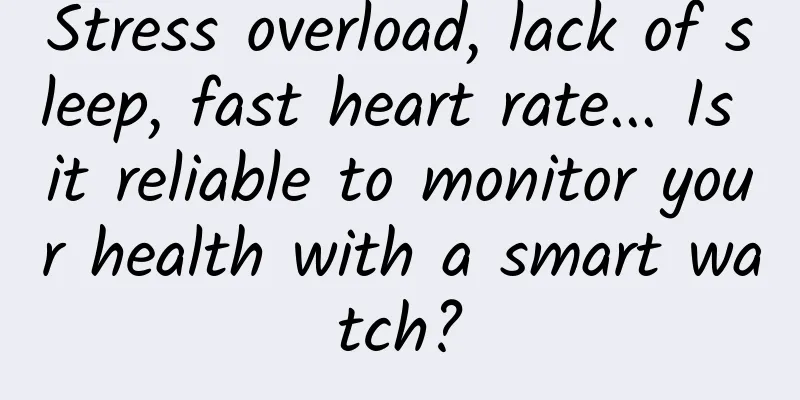Stress overload, lack of sleep, fast heart rate... Is it reliable to monitor your health with a smart watch?

|
"I only had 3 hours of deep sleep last night!" “Why do you keep reminding me of stress overload?” “Today is another perfect ‘closed loop’ day!” Nowadays, with the popularity of wearable devices, many people are eager for more "accurate" health information and a more "scientific" lifestyle. From counting exercise steps to sharing health data with friends, more and more people choose wearable devices such as smart watches to monitor their health. However, some netizens said that wearing a smart watch is like being a "sports prisoner" who voluntarily puts on "electronic shackles". They cannot be "released" unless they hit a new high in calorie consumption. Others said that they clearly do not feel stressed, but the watch reminds them that they are overloaded, which increases their psychological burden. Smart watch source: Xinhua News Agency How do smart watches sense changes in our bodies? Stress scores, breathing rates, deep sleep time...are these data real? How should people view these data? The reporter interviewed Sun Wensheng, associate professor at the School of Communication, Hangzhou Dianzi University. How do smart watches achieve monitoring? In recent years, with the advancement of artificial intelligence, big data and other technologies, smart watches have developed rapidly. From heart rate, blood pressure to stress, sleep, etc., smart watches are like the most enthusiastic employees in the company, eager to make all the conditions of your body into a visual PPT and show it to you. So, how do smart watches sense changes in our bodies? Sun Wensheng explained to reporters how smart watches work. He said that smart watches on the market mainly use sensors to directly measure the user's vital signs. Nowadays, a smart watch weighing dozens of grams can integrate multiple sensors, such as pulse sensors, position sensors, blood pressure sensors, blood oxygen sensors, temperature sensors, etc. "Smart watches use sensors to directly measure basic indicators, such as blood pressure, pulse, respiratory rate and body temperature, and then combine these data to provide a range of health information." Sun Wensheng said that taking the currently popular sleep monitoring as an example, during deep sleep, vital signs such as heart rate and blood pressure are different from when awake. Smart watches can use this to judge the user's sleep state. Of course, this judgment is generally based on a model built through deep learning using artificial intelligence methods, and is usually placed on a server. "Some data are estimated through algorithms based on directly measured data. Different manufacturers may have different algorithms, and the amount of data used to train the algorithms may also be different. The algorithms of the same company may also be continuously improved, so the results obtained may also be different," said Sun Wensheng. In addition, he also said that the real-time monitoring provided by smart watches does not mean uninterrupted monitoring of every minute and every second, but intermittent monitoring, which means that the watch will collect data at different time intervals, and then combine the data from these different time periods to provide an overall monitoring result. Users are selecting smart watch functions. Source: CCTV News “Watch data can only be used as a health reminder” Currently, the data accuracy of smart watches has become an important topic of concern for consumers. For example, smart watches with sleep monitoring functions can clearly display the deep sleep and light sleep stages in the sleep cycle through detailed charts and curves. This clear visual sleep data is really eye-catching. However, these data have also caused anxiety among some consumers. Some consumers reported that although they felt they slept soundly, the deep sleep time shown on the watch might be less than three hours, which increased their psychological burden. "The accuracy of the data is mainly related to the amount of data from the watch sensors and machine learning." Sun Wensheng explained that the current way various smart watches collect data is mainly through sensors. The better the quality, the more accurate the mobile phone data. The "pressure overload" and "low blood sugar" prompted by the watch are related to the amount of data during artificial intelligence training. The more objects are trained, the more accurate the status data. The algorithm models obtained from these training results are generally installed in the server, and smart watches generally need to be connected to the Internet when making these judgments. Smart watch shows pressure overload. Photo by Lin Chenchen Sun Wensheng said that due to the lack of unified standards for measuring physical load, fatigue level and recovery status, there is the possibility of subjective speculation by algorithm engineers. "A lot of data is obtained after processing by artificial intelligence algorithms, so it can only be used as a health reminder, not an absolute medical diagnosis. To make an accurate health judgment, you still need to go to the hospital for corresponding examinations." He also reminded that when facing the health data and reminders provided by the devices, people should remain calm and rational, and there is no need to be overly anxious or dependent on these data. The information provided by these devices is only an auxiliary tool to help people better understand their health status. Where will smart watches go in the future? With the popularization of digital health services, smart watches have shown great development potential in the market. Although the market prospects are promising, there are also some potential problems and challenges in this field. In Sun Wensheng's view, smart watches first face technical challenges. He said that due to production cost control and loose wearing conditions, the collected data has certain noise points, which affects the accuracy. The amount of algorithm training data is insufficient, and there is still a certain gap in the data analysis results. Therefore, improving the sensitivity of sensors and the ability of artificial intelligence algorithm analysis will be the focus of future smart watch technology upgrades. At present, smart watches can indeed provide the public with more accurate and efficient health management solutions through in-depth analysis of large amounts of data. However, these data may also be used by some business giants, which may expose consumers' privacy. Perhaps, when people enjoy the personalized services brought by smart watches, everyone may inadvertently become a free data laborer, creating huge commercial value for technology companies. For example, a series of data collection can allow each individual to receive extremely precise marketing. Merchants will push appropriate running shoe information to a person based on the benchmark mileage of running shoes replacement. Feedback of smart watch data on mobile phone APP Source: CCTV News Sun Wensheng said that at present, data security issues have received great attention, and corresponding laws and regulations have been introduced to regulate them. For wearable devices such as smart watches, they mainly process data through artificial intelligence algorithms. Therefore, when inputting data into the model, avoiding information involving personal privacy is also one of the solutions. It is understood that last year, relevant departments in my country issued the "Interim Measures for the Management of Generative Artificial Intelligence Services", taking the lead in legislation globally, putting forward requirements for data use, algorithm design, and value orientation, and providing support for the healthy development of the industry. "Overall, I think its prospects are definitely good. In the future, it will be able to expand more functions and application scenarios, and even provide emotional value, perceive physical health status from data monitoring of vital signs, and provide solutions to help users develop good health habits." Sun Wensheng said. |
<<: I take a walk after three meals a day, but my heart vessels are still blocked. What's going on?
Recommend
Female nipple hair growth
Generally, adolescence is an important period of ...
What can women eat to improve their immunity?
People with poor immunity will naturally have poo...
Will menstruation occur with premature ovarian failure?
Many middle-aged women suffer from premature ovar...
What is double uterine appendage?
The uterus is a female reproductive organ that is...
What's wrong with cold soles of feet?
Due to their physical constitution, women are pro...
What to do if pregnant women have acid reflux
The symptom of acid reflux in pregnant women is r...
The first menstrual period after childbirth is very light
After a woman gives birth, her menstrual cycle wi...
Live broadcast|Liu Xia from Shenzhen Children's Hospital: How much do you know about precocious puberty in children?
In recent years, affected by economic development...
What should women eat to replenish qi and nourish blood
For us women, qi and blood are vital. When qi and...
What to do if a pregnant woman has a severe headache
Headache is a common disease in our lives. It has...
How to use eye drops correctly when eyestrain occurs
Photo/Pang Hao, Yu Ying, Xiao Zhibo, The Second A...
What if my period doesn’t end after 13 days?
As we all know, women's menstruation usually ...
Will the water lily stems be frozen to death if they are exposed outside in winter? How to grow water lilies well?
Water lilies are loved by people because of their...
What is the reason for excessive vaginal discharge?
To put it simply, leucorrhea is a liquid secreted...
Healthy breast enhancement method
For many girls who love beauty, you have relative...









